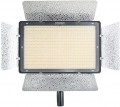Brightness
The standard brightness of the on-camera light (see "Type"). Usually, most of these models have the ability to adjust the brightness, so the maximum value is given in the specifications.
When shooting at a short distance, devices that are too bright can “overexpose” the scene, degrading the quality of the shooting (and it can be much more difficult to compensate for excessive brightness in post-processing than the lack of light). So when choosing for this indicator, it is worth proceeding from the specific conditions of use.
Power management
The ability to manually change the power of the light flux emitted by the flash (with the pulse duration unchanged, see above). This feature is present in most modern models; it allows you to set the optimal parameters for shooting, so as not to "overexpose" the frame.
The characteristics of models with power control usually indicate the levels to which it can be set. Traditionally, each subsequent (in descending order) level corresponds to half the power of the previous one, and they are designated by fractional numbers: 1/1 (full power), 1/2, 1/4, 1/8, etc. The features of flash power control depending on the shooting parameters are described in detail in special sources, but in any case, the more settings levels, the more opportunities you have to set the optimal parameters. This is especially true for shooting at short distances, where the risk of excessive "exposure" increases.
Screen
The flash has its own built-in
display. This feature greatly simplifies management and even provides a number of additional features. Various service information can be displayed on the display — from a simple display of various parameters (pulse duration, scattering angles, etc.) and ending with data from special calculators that provide the calculation of optimal shooting parameters.
Screen backlight
The flash display (see above) has its own
backlight. Thanks to this function, information on the display will be visible even in complete darkness. Note that the backlight consumes battery power, which accordingly affects battery life.
In the box
Additional items included with your flash or on-camera light.
—
1/4" mount. A special adapter with a standard 1/4" thread. Such mounts ensure compatibility of lighting equipment with universal accessories (for example, tripods), providing greater freedom in setting up the filming process.
—
Diffuser. A diffuser, or in other words a softbox, is an accessory that diffuses and softens the light emitted by an on-camera lighting device. Its use allows you to achieve a uniform nature of scene lighting, avoiding harsh shadows, glare and "overexposure". In the video light category, a diffuser can play a visual effect - change the color temperature or the color of the glow. Note that several different colored diffusers are often supplied in the kit.
—
Curtains. Adjustable plates in the form of characteristic petals that are attached to the on-camera light source and allow for flexible adjustment of light accents. Curtains are used to change the direction and distribution of the light flow — wide-open plates provide full coverage of the scene, while closed petals narrow the light flow and direct it “in the right direction” (i.e. to a specific part of the scene). Most often, curtains are used to adjust backlighting and background lighting.
— Battery. The presence of a battery in the delivery set of battery-powered lighting equipment. Eliminates th
...e need to purchase a battery separately. This item refers to a removable battery (see "Power source"), but may also indicate the absence of a battery in the standard package - in this case, you will need to purchase it additionally.
— Power supply. A device for connecting a lighting device to the mains. This connection can be used for two main purposes — operating the light source from a socket (see "Power supply from the mains") and charging the battery directly in the device itself. Modern models of on-camera lighting can support either one of these functions or both at once — the details should be clarified additionally. It should also be noted that not all devices with the ability to operate from the mains are initially equipped with power supplies — in some cases, such an accessory must be purchased separately.
— Charger. A device for charging the standard battery of a lighting device. Chargers are supplied with models that operate from specialized batteries of a removable design (see "Power source"). And if such a model allows charging the battery directly in the device, and the set includes an adapter for connecting to a socket, it is no longer considered a charger, but a power supply (see above).
— Remote control. As a rule, individual on-camera lights and lightsabers (see "Type") are equipped with a remote control. It allows remote control of the lighting device settings: turning it on and off, adjusting the brightness, changing the color temperature, activating various lighting effects, controlling several light sources combined into a group, etc. The actual set of remote control functions may differ depending on the specific implementation.
— Case/bag. The presence of a bag or case in the standard configuration of the lighting device. Bags are often equipped with handles or a strap for easy carrying, a case is somewhat simpler - it does not have handles and is designed to be carried in a bag for photographic equipment, a backpack, etc. A bag or case covers the device from dust and other contaminants, to some extent protects the contents from damage from impacts and falls.
